Five new species of fauna have been recorded for Singapore, after they were uncovered on Pulau Ubin during surveys done by the National Parks Board (NParks) and the research community last year.
The new species recorded are the little stint shorebird, long-winged tomb bat, big-eared pipistrelle bat, arrow emperor dragonfly and raccoon pseudo-orb weaver spider.
These add to Pulau Ubin's diverse biodiversity, said Minister for Social and Family Development and Second Minister for National Development Desmond Lee yesterday.
"They are testament to the biodiversity Ubin contributes to Singapore, and remind us of our role as stewards, custodians and guardians of our natural heritage," added Mr Lee, who was on the island to mark Ubin Day.
The event had several activities, such as kampung games and educational booths, to celebrate the different facets of Pulau Ubin.
Of special significance is the identification of the little stint shorebird, which is a rare sighting in South-east Asia. Two little stints were identified by experts following a survey of shorebirds at the Chek Jawa Wetlands in September last year.
Two species of bats, which can be found only on Pulau Ubin, were also recorded for Singapore.
The long-winged tomb bat has wings that are long and narrow, while the big-eared pipistrelle has large, broad ears and whitish, translucent wings. Both insectivorous bat species were identified during a field survey at Chek Jawa in December last year.
The other newly recorded species - the arrow emperor dragonfly and the raccoon pseudo-orb weaver spider - were discovered last year.
The dragonfly has a distinct T-mark on the front area of its head and an elongated third abdominal segment. The long-legged, medium-sized spider has patterns that resemble a raccoon's tail.
Dr Adrian Loo, group director of conservation at NParks, said ongoing biodiversity conservation efforts may have had a part to play in the discovery of these species here.
He added that the next step would be to conduct studies to find out the species' population and distribution, among other things, so as to help conserve their habitats.
Yesterday, Mr Lee, together with Trade and Industry Minister Chan Chun Sing, toured the improved facilities at the Ubin Living Lab, which supports field studies and environmental education on the island.
A new working space, equipped with a workbench and wood-working equipment, will allow restoration work to be done on-site rather than having to bring completed pieces from the mainland.
Water treatment systems, as well as toilet and shower amenities, will also make it more conducive for students and researchers to stay over on the island for various research and educational activities.
Throughout Pulau Ubin, earth tracks and drains have been improved to offer better accessibility. Fire extinguishers and litter bins have also been distributed to every household, so residents can enjoy a safer and cleaner environment.
Mr Lee said: "These small, little enhancements mean a lot to the people living on this island, and the people who work on projects on Ubin.
"We will continue to enhance Pulau Ubin in a way that respects the character and integrity of its built heritage, while ensuring that our residents can continue their way of life."



